What's inside
What's inside
 Key Ingredients
Key Ingredients

 Benefits
Benefits

 Concerns
Concerns

 Ingredients Side-by-side
Ingredients Side-by-side

Water
Skin ConditioningPropylene Glycol
HumectantNiacinamide
SmoothingGlyceryl Stearate
EmollientIsohexadecane
EmollientGlycerin
HumectantPEG-100 Stearate
Stearic Acid
CleansingGlycereth-26
HumectantSaccharide Isomerate
HumectantCarbomer
Emulsion StabilisingSoluble Collagen
HumectantSqualane
EmollientTriethanolamine
BufferingChlorphenesin
AntimicrobialTocopheryl Acetate
AntioxidantPropanediol
SolventAllantoin
Skin ConditioningDisodium EDTA
Xanthan Gum
EmulsifyingSalix Alba Bark Extract
AstringentMagnesium Carboxymethyl Beta-Glucan
Skin ConditioningSodium Hyaluronate
HumectantTremella Fuciformis Sporocarp Extract
AntioxidantCholesterol
EmollientCeramide NP
Skin ConditioningCaprylic/Capric Triglyceride
MaskingHydrogenated Lecithin
EmulsifyingOleic Acid
EmollientPhytosphingosine
Skin ConditioningCitric Acid
BufferingSodium Citrate
BufferingCaprylyl Glycol
EmollientLactic Acid
BufferingCaprylhydroxamic Acid
Water, Propylene Glycol, Niacinamide, Glyceryl Stearate, Isohexadecane, Glycerin, PEG-100 Stearate, Stearic Acid, Glycereth-26, Saccharide Isomerate, Carbomer, Soluble Collagen, Squalane, Triethanolamine, Chlorphenesin, Tocopheryl Acetate, Propanediol, Allantoin, Disodium EDTA, Xanthan Gum, Salix Alba Bark Extract, Magnesium Carboxymethyl Beta-Glucan, Sodium Hyaluronate, Tremella Fuciformis Sporocarp Extract, Cholesterol, Ceramide NP, Caprylic/Capric Triglyceride, Hydrogenated Lecithin, Oleic Acid, Phytosphingosine, Citric Acid, Sodium Citrate, Caprylyl Glycol, Lactic Acid, Caprylhydroxamic Acid
Water
Skin ConditioningAlcohol Denat.
AntimicrobialDiisopropyl Sebacate
EmollientSilica
AbrasiveIsopropyl Myristate
EmollientEthylhexyl Salicylate
UV AbsorberEthylhexyl Triazone
UV AbsorberBis-Ethylhexyloxyphenol Methoxyphenyl Triazine
Skin ConditioningButyl Methoxydibenzoylmethane
UV AbsorberGlycerin
HumectantPropanediol
SolventC12-22 Alkyl Acrylate/Hydroxyethylacrylate Copolymer
StabilisingDrometrizole Trisiloxane
UV AbsorberPerlite
AbsorbentCaprylic/Capric Triglyceride
MaskingTocopherol
AntioxidantHydroxyacetophenone
AntioxidantHydroxyethylcellulose
Emulsion StabilisingSodium Hyaluronate
HumectantTriethanolamine
BufferingTrisodium Ethylenediamine Disuccinate
Silica Silylate
EmollientLimonene
PerfumingLinalool
PerfumingCaprylyl Glycol
EmollientAlpha-Isomethyl Ionone
PerfumingTerephthalylidene Dicamphor Sulfonic Acid
UV AbsorberAcrylates/C10-30 Alkyl Acrylate Crosspolymer
Emulsion StabilisingHexyl Cinnamal
PerfumingParfum
MaskingWater, Alcohol Denat., Diisopropyl Sebacate, Silica, Isopropyl Myristate, Ethylhexyl Salicylate, Ethylhexyl Triazone, Bis-Ethylhexyloxyphenol Methoxyphenyl Triazine, Butyl Methoxydibenzoylmethane, Glycerin, Propanediol, C12-22 Alkyl Acrylate/Hydroxyethylacrylate Copolymer, Drometrizole Trisiloxane, Perlite, Caprylic/Capric Triglyceride, Tocopherol, Hydroxyacetophenone, Hydroxyethylcellulose, Sodium Hyaluronate, Triethanolamine, Trisodium Ethylenediamine Disuccinate, Silica Silylate, Limonene, Linalool, Caprylyl Glycol, Alpha-Isomethyl Ionone, Terephthalylidene Dicamphor Sulfonic Acid, Acrylates/C10-30 Alkyl Acrylate Crosspolymer, Hexyl Cinnamal, Parfum
 Reviews
Reviews

Ingredients Explained
These ingredients are found in both products.
Ingredients higher up in an ingredient list are typically present in a larger amount.
This ingredient is an emollient, solvent, and texture enhancer. It is considered a skin-softener by helping the skin prevent moisture loss.
It helps thicken a product's formula and makes it easier to spread by dissolving clumping compounds.
Caprylic Triglyceride is made by combining glycerin with coconut oil, forming a clear liquid.
While there is an assumption Caprylic Triglyceride can clog pores due to it being derived from coconut oil, there is no research supporting this.
Learn more about Caprylic/Capric TriglycerideCaprylyl Glycol is a humectant and emollient, meaning it attracts and preserves moisture.
It is a common ingredient in many products, especially those designed to hydrate skin. The primary benefits are retaining moisture, skin softening, and promoting a healthy skin barrier.
Though Caprylyl Glycol is an alcohol derived from fatty acids, it is not the kind that can dry out skin.
This ingredient is also used as a preservative to extend the life of products. It has slight antimicrobial properties.
Learn more about Caprylyl GlycolGlycerin is already naturally found in your skin. It helps moisturize and protect your skin.
A study from 2016 found glycerin to be more effective as a humectant than AHAs and hyaluronic acid.
As a humectant, it helps the skin stay hydrated by pulling moisture to your skin. The low molecular weight of glycerin allows it to pull moisture into the deeper layers of your skin.
Hydrated skin improves your skin barrier; Your skin barrier helps protect against irritants and bacteria.
Glycerin has also been found to have antimicrobial and antiviral properties. Due to these properties, glycerin is often used in wound and burn treatments.
In cosmetics, glycerin is usually derived from plants such as soybean or palm. However, it can also be sourced from animals, such as tallow or animal fat.
This ingredient is organic, colorless, odorless, and non-toxic.
Glycerin is the name for this ingredient in American English. British English uses Glycerol/Glycerine.
Learn more about GlycerinPropanediol is an all-star ingredient. It softens, hydrates, and smooths the skin.
It’s often used to:
Propanediol is not likely to cause sensitivity and considered safe to use. It is derived from corn or petroleum with a clear color and no scent.
Learn more about PropanediolSodium Hyaluronate is hyaluronic acid's salt form. It is commonly derived from the sodium salt of hyaluronic acid.
Like hyaluronic acid, it is great at holding water and acts as a humectant. This makes it a great skin hydrating ingredient.
Sodium Hyaluronate is naturally occurring in our bodies and is mostly found in eye fluid and joints.
These are some other common types of Hyaluronic Acid:
Learn more about Sodium HyaluronateTriethanolamine is an emulsifier and pH adjuster. It is created using ethylene oxide and ammonia. This gives Triethanolamine a nitrogen core and a similar scent to ammonia.
As an emulsifier, it prevents ingredients from separating and enhances texture by adding volume to a product.
PH adjusters are common in cosmetic products. The pH of a product can affect the effectiveness of other ingredients. A product with a high pH may also irritate the skin.
Learn more about TriethanolamineWater. It's the most common cosmetic ingredient of all. You'll usually see it at the top of ingredient lists, meaning that it makes up the largest part of the product.
So why is it so popular? Water most often acts as a solvent - this means that it helps dissolve other ingredients into the formulation.
You'll also recognize water as that liquid we all need to stay alive. If you see this, drink a glass of water. Stay hydrated!
Learn more about Water